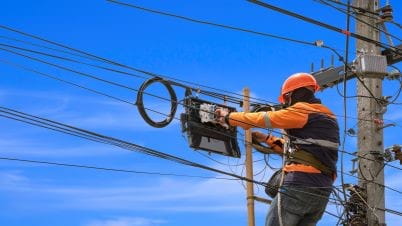Real-time solutions on mobiles, with cloud-based apps, aid field service management in minimizing operational risks.

From 2014-2019, 85% of oil and gas extraction (OGE) worker fatalities in the U.S. were due to occupational injuries, according to a report from Centers for Disease Control and Prevention. The industry’s injury rate is historically seven times higher than for all U.S. workers.
That datapoint alone makes preserving the safety and security of field workers of paramount importance to any energy and utilities company. Yet, while these amenities are vital to society – making them both high profile and price sensitive – the workplace can often be hazardous.
In fact, field workers regularly face challenges that put them at risk. The pressure to maintain quality of service and operational efficiency can create a sense of uncertainty around operational tasks. This is exacerbated by the fact that they often work alone in locations that may be remote or demanding, without access to real-time communications and collaboration tools.
These are all challenges that can be addressed. In this blog I will discuss some of these concerns as well as the solutions that will make the life of the energy and utilities field worker much safer and more productive.
A challenging mission
Energy and utilities off-site workers are exposed to many kinds of tasks that put them at risk of falls, electrocution, and even suffocation or extreme physical endangerment. These tasks include:
- Climbing scaffolding or working at the top of radio or electric power line transmission towers to maintain or repair equipment
- Working in confined spaces or underground to deal with gas equipment, shut off gas lines or repair downed lines and high voltage cabinets
There is also risk of harm from members of the public, who may react aggressively due to frustrations with service disruption.
In some situations, the remoteness of the work may lead to a sense of isolation and be demotivating. As a result, the field worker may feel disconnected from their organisation and be unable to deal properly with deadline pressures, causing them to take unnecessary risks.
Mobility and Isolated Worker Protection
Real-time communications solutions based on Isolated Worker Protection (IWP) capabilities and cloud-based applications, designed for mobile devices, are crucial to helping field service management minimise these risks.
IWP, based on a DECT infrastructure, is intended for both indoor and outdoor campus sites. The DECT handset enables constant monitoring of the field worker and can trigger an alarm when help is needed. The man-down, red button, pull cord and explosion-proof capabilities for hazardous environments are some of the functionalities that allow the field worker to cope with security risks. Compliant with DGUV 112-139 lone worker certification, the handset has features such as prevention of device switch-off and prioritisation of alarms over any communication. In a scenario where the field technician performing a critical task in a gas plant falls unconscious due to a toxic gas leak, the DECT handset will detect lack of movement in either a horizontal or vertical position and trigger a man-down alarm that will alert control centre staff to react.
Collaboration and remote assistance
At times, hazardous situations and complex tasks for the field technician require real-time assistance from an expert in the control centre. This is the case inside high voltage cabinets, where there is a risk of burns or electrocution. With the cloud-based Remote Visual Assistance (RVA) solution, the expert can “see what the field technician sees” through a multimedia video session and provide instructions to safely complete the task. Staff can also share files, take pictures and record video offline to be uploaded in the server for tracking and training purposes.
As well, because field service efficiency can impact service quality for the customer, field service is closely tied to customer satisfaction and retention – and ultimately company revenues.
While field service efficiency depends on many factors – technician’s knowledge, tool availability, task reports, service and production downtime, real-time information to reschedule tasks – fixing a problem on the first and only visit is ideal. In fact, according to Aberdeen Group research*, a First Time Fix Rate (FTFR) of more than 70% equates to customer retention rates of 86%.
This is another area where the RVA can help. Real-time remote collaboration with an expert means field technicians can resolve more problems without a follow-up visit.
Training and knowledge sharing
Facilitating the training process and knowledge transfer are fundamental to improving the expertise and efficiency of field workers.
Rainbow ClassRoom is a digital training and knowledge sharing tool that equips experts to deliver training through virtual and multimedia sessions, Rainbow ClassRoom enables the field worker team to stay up to date with new technologies and access concrete examples of scenarios they will deal with every day.
The future of the field worker
All of these tools are available to field service workers today, and more are coming. Cloud-based applications, Augmented Reality (AR), Extended Reality (XR), IoT and AI can be integrated into the current ecosystem to enrich working conditions. And the openness provided by APIs is fundamental to interworking between different systems and adding value to the current environment.
Imagine a scenario where a field worker must troubleshoot a failure at the electric switchboard in a high voltage cabinet. With XR capabilities, a 3D model of the switchboard, complete with expert notes, is accessible in advance: the worker can review it and be fully prepared for the task upon arrival.
All these technology building blocks enable the field worker to be more efficient, productive and safer, leading to customer satisfaction, corporate success, and a steady flow of the energy and utilities that our communities need to thrive.
Latest Blogs

Supply chain resilience and business adaptability
Strategic supply chain resilience and business adaptability to thrive in the face of adversity

Solve education challenges with a modern campus network
A modern campus network helps streamline operations, reduce costs, and offers a safe and caring place to work and study.

Revitalise education with a modern campus network
A modern, campus-wide network upgrade aligns capabilities with academic, research and business priorities today and tomorrow.

Education today: Why modernising campus networks is a must
Educational institutions worldwide must modernise their networks to meet today’s new requirements.

